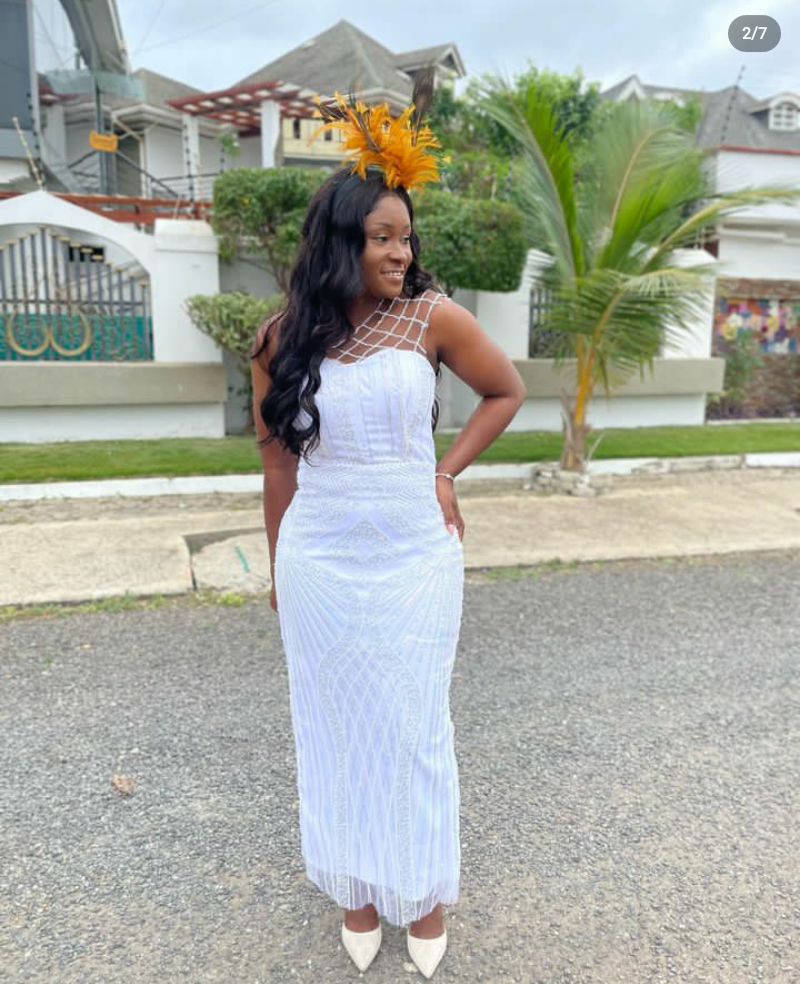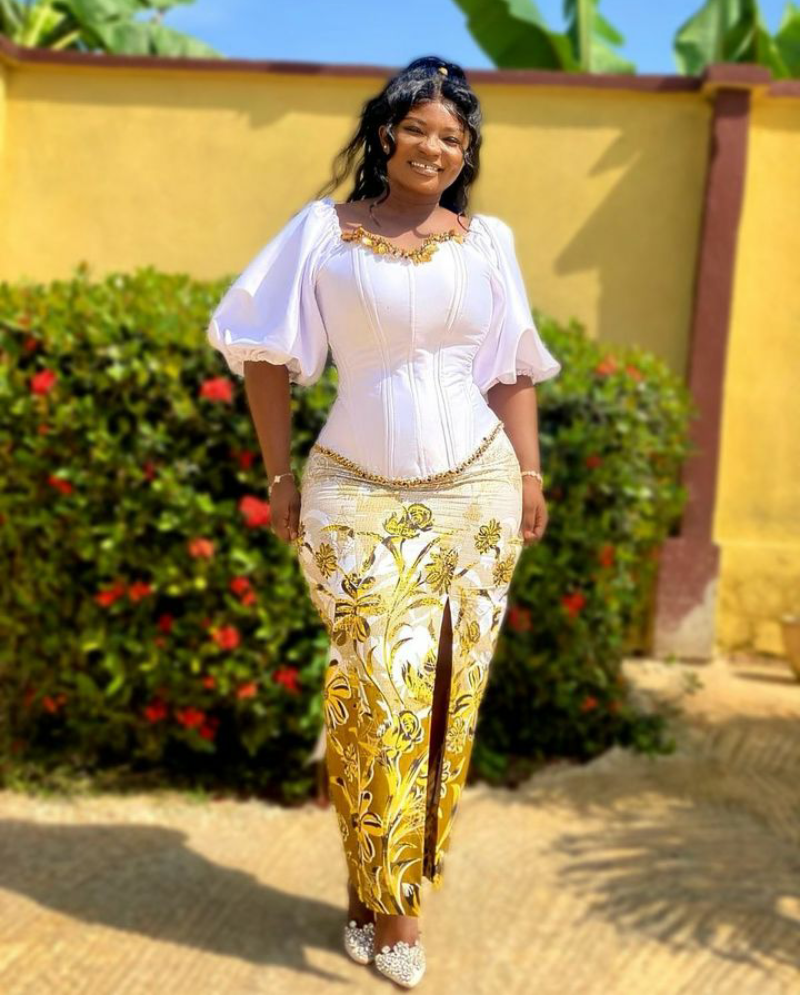
In Ghana, one of the most cherished and joyous occasions is a naming ceremony. This event not only serves to introduce a newborn baby to friends and family but also symbolizes the importance of tradition and heritage in Ghanaian culture.
Alongside all the excitement and love that fills the air during these ceremonies, there is a strong emphasis on dressing appropriately. In this blog post, we will explore the various dress styles for a Ghanaian naming ceremony, showcasing the rich and vibrant fashion that truly captures the essence of this cultural celebration.

Kente: The Epitome of Ghanaian Elegance
When it comes to traditional Ghanaian attire, Kente fabric is undoubtedly the epitome of elegance. Originating from the Ashanti kingdom, Kente fabric is handwoven with vibrant and intricate patterns using brightly colored silk or cotton threads.
For naming ceremonies, both men and women often opt for Kente cloth attire. Women wear Kente dresses, known as “Kaba and Slit,” which consist of a fitted top paired with a long, flowing skirt.
Men typically choose to wear a matching Kente cloth “Boubou” or a Kente cloth shirt paired with loose-fitting trousers. The vibrant colors and mesmerizing patterns of Kente fabric not only showcase Ghanaian artistry but also add a sense of grandeur to the celebration.

Printed Ankara Fabric: A Fusion of Tradition and Modernity
Ankara fabric, also known as African wax print or Holland wax, has gained immense popularity across the African continent and the diaspora. For Ghanaian naming ceremonies, Ankara fabric is often used to create stunning dresses and outfits that fuse traditional aesthetics with modern designs.
Ankara dresses for women are usually tailored to flatter the figure, featuring various styles such as mermaid cuts, A-line dresses, or peplum tops paired with skirts or trousers.

Men can opt for Ankara shirts paired with trousers or complete Ankara outfits. The versatility of Ankara fabric allows individuals to express their personal style while embracing their Ghanaian heritage.

White Clothing:
White attire is also popularly worn at naming ceremonies in Ghana. White symbolizes purity, cleanliness, and spiritual growth. It is believed to bring blessings and protection to the newborn.
For men, a simple white shirt paired with trousers or a white batakari can be a suitable choice. Women can wear a white wraparound skirt and blouse or a full-length white dress. Adding a touch of color through accessories, such as a beaded necklace or a waist bead, can enhance the overall look.


Modern Fusion:
While traditional attire remains dominant at naming ceremonies, some individuals prefer to incorporate modern elements into their outfits. This fusion style allows for creativity and personalization. Men can pair a modern blazer with a traditional cloth, while women can wear a modern-style dress made from kente or other Ghanaian fabrics. The aim is to strike a balance between tradition and contemporary fashion.

Beaded Dresses:
Beaded dresses are another fashionable choice for naming ceremonies in Ghana. These dresses are intricately embellished with colorful beads, creating a stunning and eye-catching effect. Women can opt for beaded dresses in various styles, such as a fitted dress, a wrap dress, or a flowing maxi dress. Pairing the dress with matching beaded accessories, like earrings or bangles, adds a touch of elegance.


Corset dress
The corset dress is a versatile ensemble that effortlessly blends Western and Ghanaian fashion influences. The corset, known as “kaba” in Ghana, is typically made of colorful and intricately patterned fabric.
It cinches the waist and accentuates the woman’s curves, adding a touch of femininity and elegance. The skirt, called “slit,” is usually made from a matching fabric or a complementary color. It flows gracefully to the ankles, allowing for easy movement while maintaining a sophisticated appearance.
One of the reasons why the corset dress is a popular choice for naming ceremonies is its versatility. This outfit can be personalized in various ways to suit your style and preferences. The corset can be decorated with embroidery, beads, or sequins, adding extra sparkle and glamour.
Additionally, the skirt can be tailored according to your desired length and shape, whether you prefer a mermaid cut or a flared design. The possibilities are endless when it comes to creating a unique and personalized corset dress.

When choosing the fabric for your corset dress, consider opting for traditional Ghanaian textiles such as Kente or Ankara. These fabrics are known for their vibrant colors, intricate patterns, and rich cultural significance. By wearing a corset dress made from these fabrics, you not only pay homage to the Ghanaian culture but also support the local textile industry.
To complete your look, consider accessorizing your corset dress with traditional Ghanaian jewelry, such as beaded necklaces, bracelets, and earrings. Adorn your hair with a stylish headwrap or fascinator, and opt for comfortable yet stylish footwear, such as embellished sandals or traditional leather slippers or heels.

White lace dresses
White lace dresses are a traditional and popular choice for Ghanaian mothers during newborns’ naming ceremonies. These dresses show elegance, beauty, and purity, perfectly symbolizing the joy and celebration associated with this milestone in the baby’s life. The intricate lace patterns and delicate fabric add a touch of sophistication and create a visually captivating outfit.
The choice of white, in particular, holds cultural significance in Ghanaian traditions. White represents purity, innocence, and spirituality. It also symbolizes the hopeful future ahead for the baby, bringing blessings and success to their life journey. By adorning a white lace dress, the mother not only compliments her own beauty but also creates a visual representation of these symbolic meanings.

Ghanaian women are known for their impeccable fashion sense and attention to detail, and this holds true especially for special occasions like the naming ceremony. The white lace dress is often accompanied by vibrant accessories, such as colorful gele headwraps, beaded necklaces, and matching shoes. These accessories not only enhance the overall aesthetic but also add cultural flair to the ensemble, reflecting the richness of Ghanaian traditions.

Adinkra Symbolic Clothing: Wearing Tradition with Pride
Adinkra symbols, a unique part of Ghanaian culture, are often incorporated into clothing during naming ceremonies. These symbols, which represent various concepts and values, are traditionally printed or embroidered onto fabric using black dye made from the bark of a local tree.
Participants in the naming ceremony wear clothing embellished with Adinkra symbols to express their cultural identity and values. These symbols can be found on dresses, shirts, or accessories, allowing individuals to proudly connect with their heritage and share their values with the community.

Related Posts






A Ghanaian naming ceremony is a time of great joy, love, and celebration. Dressing appropriately and respectfully for this event not only honors Ghanaian culture but also adds to the overall ambiance of the occasion. Whether you choose traditional attire or opt for a modern fusion look, embrace the opportunity to showcase the beautiful fashion of Ghana while celebrating the new life being welcomed into the world.




